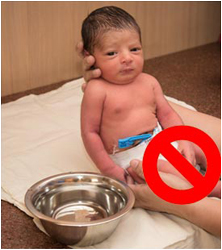Prevention of hypothermia in preterm infants
- Introduction...
- 1. What is warm ch...
- 2. Keep the room w...
- 3. Skin-to-skin co...
- 4. Warm resuscitat...
- 5. Immediate dryin...
- 6. Exclusive breas...
- 7. Postpone bathin...
- 8. Appropriate clo...
- 9. Keep with mothe...
- 10. Warm transport...
- 11. Training and a...
- 12. Summary...
 |
 |
Introduction
DR. NISHAD PLAKKAL
MD (Pediatrics)
Assistant Professor
Department of Neonatology
JIPMER, Pondicherry
1. What is warm chain?
► Warm chain is a series of interlinked steps to prevent
hypothermia in neonates
2. Keep the room warm
► Make sure the delivery room is kept at 25-28°C

3. Skin-to-skin contact (STS)
► For stable babies, start skin-to-skin contact on the
mother's abdomen immediately after birth
► Allow breast crawl for up to an hour
► Postpone vitamin K and weighing until after skin to skn contact
4. Warm resuscitation
► Switch on warmer 20-30 minutes before delivery
► Warm at least 2 sheets

5. Immediate drying
► Dry skin with linen
► Discard wet linen after wiping
► Wrap in dry towel
► Cover head or put cap on
► Plastic bag/wrap if < 32 weeks

6. Exclusive breastfeeding
► Continue skin-to-skin care
► Breastfeed within 1 hour
► Feed as soon as possible after C-section
► Discourage prelacteal feeds
7. Postpone bathing

Postpone bathing for 24 hours
8. Appropriate clothing
► Cover head, use cap, socks, and mittens
► Extra clothing in winter
► Change wet nappies promptly
9. Keep with mother

► Rooming in
► Bedding in
► If not in Kangaroo Mother Care, wrap and place next to
mother
10. Warm transportation

► Transport incubator
► Skin-to-skin
► Wrapping
► In-utero transfer for high-risk pregnancies
11. Training and awareness
► Educate all members of team
► Train all members in resuscitation, skin-to-skin,
breastfeeding, use of equipment like radiant warmers and
incubators
► Ongoing program to train new staff and retrain others
12. Summary
► Increased awareness and a series of simple measures are all
that is needed to prevent hypothermia in most neonates
